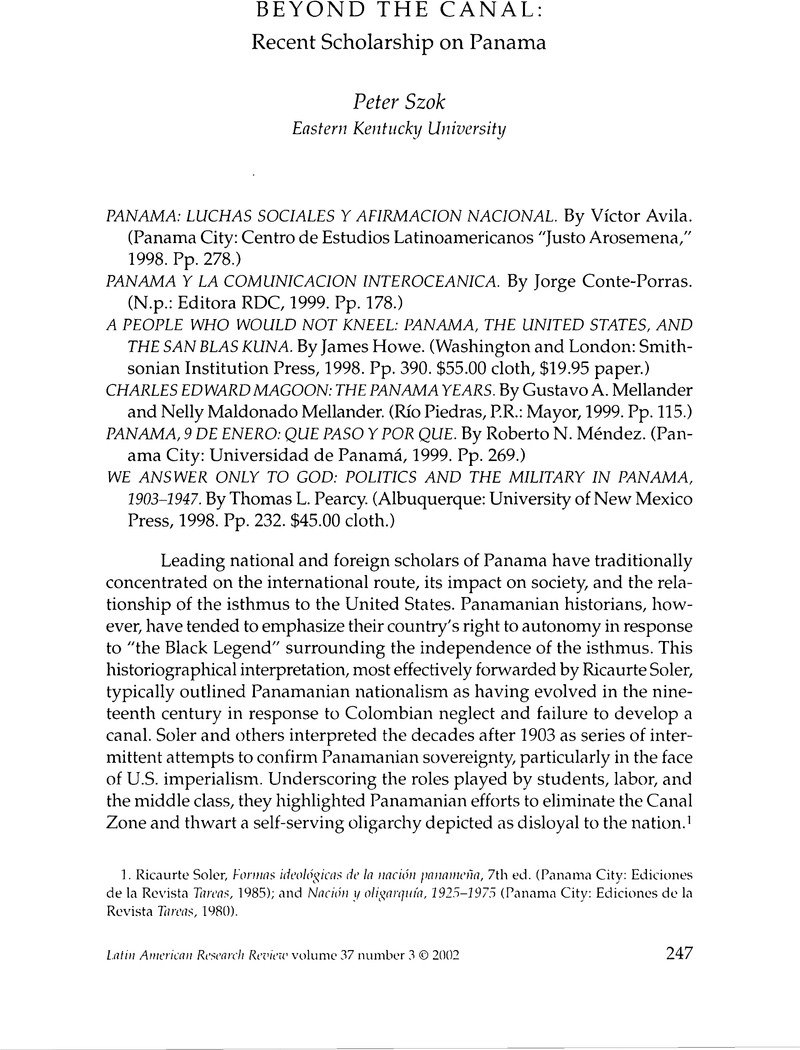No CrossRef data available.
Published online by Cambridge University Press: 05 October 2022

1. Ricaurte Soler, Formas ideológicas de la nación panameña, 7th ed. (Panama City: Ediciones de la Revista Tareas, 1985); and Nación y oligarquía, 1925-1975 (Panama City: Ediciones de la Revista Tareas, 1980).
2. Gerstle Mack, The Land Divided: A History of the Panama Canal and Other Isthmian Canal Projects (New York: Knopf, 1944); William McCain, The United States and the Republic of Panama (Durham, N.C.: Duke University Press, 1937); and Dwight Carroll Miner, The Fight for the Panama Route: The True Story of the Spooner Act and the Hay-Herrán Treaty (New York: Octagon, 1966).
3. Panamanian authors on occasion have also taken this same position, presenting their country as little more than an invention of the United States. A classic example is Oscar Terán, Del tratado Herrán-Hay al Tratado Hay-Bunau-Varilla: Historia crítica del atraco Yanki, mal llamado en Colombia la pérdida de Panamá y en Panamá nuestra independencia de Colombia (Panama City: Imprenta de “Motivos Colombianos,” 1934-1935). For more recent examples, see Ovidio Díaz Espino, How Wall Street Created a Nation: J. P. Morgan, Teddy Roosevelt, and the Panama Canal (New York: Four Walls, Eight Windows, 2001); and John Weeks and Phil Gunson, Panama: Made in the USA (London: Latin American Bureau, 1991).
4. Celestino Andrés Araúz, Carlos Manuel Gasteazoro, and Armando Pinzón, as quoted by Pearcy (p. xii).
5. For examples of these studies focusing on foreign affairs, see Harmodio Arias, El Canal de Panamá: Un estudio en derecho internacional y diplomacia (Panama City: Editora Panamá América, 1957); Ricardo J. Alfaro, Historia documentada de las negociaciones de 1926 (Panama City: Editorial Universitaria, 1972); and Ernesto Castillero Pimentel, Panamá y los Estados Unidos, 1903-1953 (Panama City: Humanidad, 1964).
6. Some of their most influential works include Alfredo Castillero Calvo, Historia de la Villa de Los Santos y los orígenes históricos de Azuero (Panama City: Dirección Nacional de Cultura, 1971); Alfredo Figueroa Navarro, Dominio y sociedad en el Panamá colombiano (1821-1903) (Panama City: Impresora Panamá, 1978); and Ornar Jaén Suárez, La población del Istmo de Panamá del siglo XVI al siglo XX (Panama City: Ornar Jaén Suárez, 1979).
7. See Celestino Andrés Araúz, La independencia de Panamá en 1821 (Panamá: Academia de la Historia, 1980); Patricia Pizzurno Gelós, Antecedentes, hechos y consequencias de la Guerra de los Mil Días en el Istmo de Panamá (Panama City: Fomato, 1990); Jorge Conte-Porras, Réquiem por la revolución (San José, C.R.: Litografía e Imprenta, 1990); María del Carmen Mena García, La sociedad de Panamá en el siglo XVI (Seville: Diputación Provincial de Sevilla, 1984); Alex Pérez-Venero, Before the Five Frontiers: Panama from 1821 to 1903 (New York: AMS Press, 1978); George Priestley, Military Government and Popular Participation in Panama (Boulder, Colo.: Westview, 1986); Humberto Ricord, Panamá en la Guerra de los Mil Días (Panama City: n.p., 1989); Steve Ropp, Panamanian Politics: From Guarded Nation to National Guard (New York: Praeger, 1982); and Andrew Zimbalist and John Weeks, Panama at the Crossroads: Economic Development and Political Change in the Twentieth Century (Berkeley and Los Angeles: University of California Press, 1991).
8. Rafael A. González, Universidad de Panamá e independencia nacional (Panama City: n.p., 1994).
9. Ernesto Castillero Reyes, Historia de la comunicación interoceánica y de su influencia en la formación y en el desarrollo de ¡a entidad nacional panameña (Panama City: Imprenta Nacional, 1941).
10. Marco A. Gandásegui, La democracia cu Panamá (Mexico City: Mestiza, 1989); Soler, Nación y oligarquía; Soler, Panamá: Historia de una crisis (Mexico City: Siglo Veintiuno, 1989); Hernando Franco Múñoz, Movimiento obrero panameño, 1914-1921 (Panama City: n.p., 1979); and Walter LaFeber, The Panama Canal: The Crisis in Historical Perspective, rev. ed. (New York: Oxford University Press, 1989).
11. Catalino Arrocha Graell, Historia de la independencia de Panamá: Sus antecendentes y sus causas, 1821-1903 (Panama City: 1933; reprint, Litho-Impresora Panamá, 1973).
12. Gustavo A. Mellander, The United States in Panamanian Politics: The Intriguing formative Years (Danville, Ill.: Interstate, 1971).
13. David McCullough, The Path between the Seas (New York: Simon and Schuster, 1977).
14. Ibid., 459-533.
15. Patricia Pizzurno Gelós and Celestino Andrés Araúz, Estudios sobre el Panamá republicano, 1903-1989 (Panama City: Manfer, 1996).
16. Jules Dubois, Danger over Panama (Indianapolis, Ind.: Bobbs-Merrill, 1964).
17. Ibid., 285-313.
18. César A. León, Significado histórico de la actual crisis entre Panamá y los Estados Unidos (Panama City: Asociación Científico-Cultural de Panamá, 1964); Alessandro Russo Berguido, ¡Panamá, nación mártir! (Panama City: n.p., 1964).
19. David Acosta, Influencia decisiva de la opinión pública en el rechazo del Convenio Filós-Hines de 1947 (Panama City: Editorial Universitaria, 1993).
20. Carlos Guevara Mann, Panamanian Militarism: A Historical Interpretation (Athens: Ohio University Center for International Studies, 1996).
21. Ibid., xviii.
22. George Priestley, Military Government and Popular Participation in Panama: The Torrijas Regime, 1968-1975 (Boulder, Colo.: Westview, 1986); Ropp, Panamanian Politics; and Sharon Phillipps Collazos, Labor and Politics in Panama: The Torrijos Years (Boulder, Colo.: Westview, 1991).
23. See, for example, Castillero Pimentel, Política exterior, 247-48.
24. Ernesto Castillero Reyes, Historia de Panamá, 9th ed. (Panama City: Renovación), 228.
25. Michael Conniff, Black Labor on a White Canal: Panama, 1904-1981 (Pittsburgh, Pa.: University of Pittsburgh Press, 1985).
26. Marsh actually published a book entitled White Indians of Darien (New York: Putnam, 1934).
27. Castillero Pimentel, Política exterior, 247.